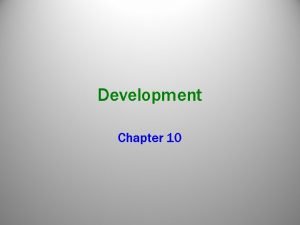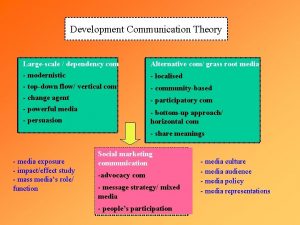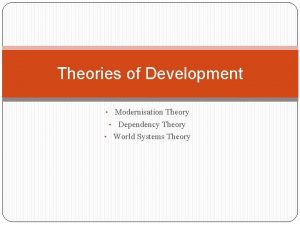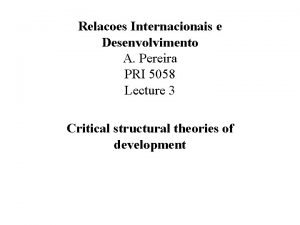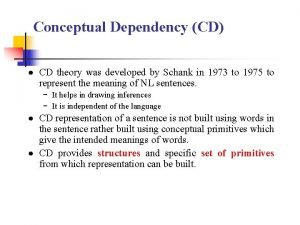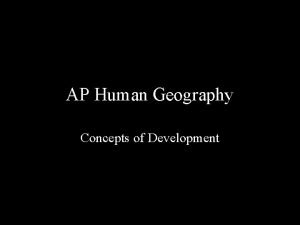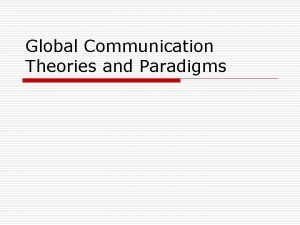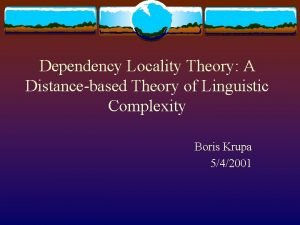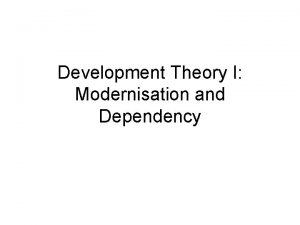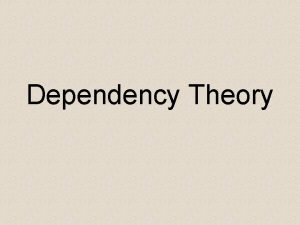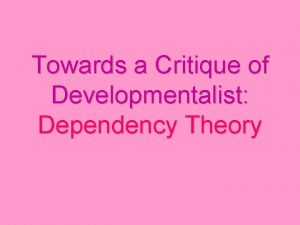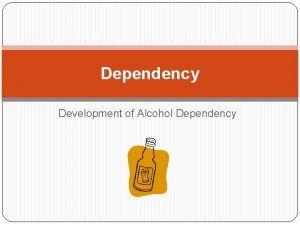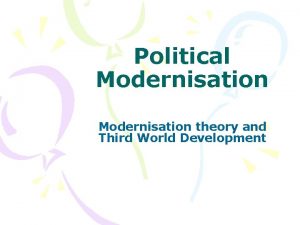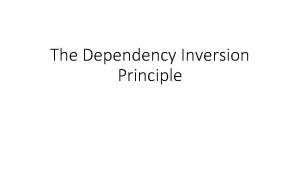Theories of Development Modernisation Theory Dependency Theory World















- Slides: 15

Theories of Development • Modernisation Theory • Dependency Theory • World Systems Theory

Modernisation theory For a country to be seen as modern, modernisation theorists say it has to undergo an evolutionary advance in science and technology which in turn would lead to an increased standard of living for all

Historical background to modernisation theory 1. 2. 3. 4. 5. Post world war two’s deepening poverty in some countries Ideological competition from communism Increasing unrest in some countries The above posed a threat to capitalism, and especially the USA This led to the development of modernisation theory (mainly by US economists and policy makers)

Modernisation theorists aimed to: a) b) explain why poorer countries failed to evolve into modern societies Reduce the spread of communism by presenting capitalist values as the solution to poverty Modernisation theory has become increasingly influential, especially since post collapse of USSR



Modernisation theory – role of the West in developing countries i. Western investment in factories, expertise and equipment – use loans from World Bank (Trickle down) ii. Western funding to introduce meritocratic education (values of universalism, individualism and competition (Hoselitz)

Modernisation theory – the West and the developing countries (continued) iii Mass media to disseminate modern ideas iv Urbanisation to be encouraged

Criticism of modernisation theory It is ethnocentric because (a) it devalues traditional values and social institutions e. g. extended families (b) it ignores increasing inequality within and between countries (c) it is not a neutral theory as it suggests (it promotes western capitalist values)

Education in developing world mainly benefits small, local elites (those at the top) It assumes unlimited natural resources for industrial expansion. (ignores ecological issues)

Many countries seemed to have become stuck at stages and can't move onto to stage 4 and 5. Developed countries only reached stage 5 by exploiting countries, now making it impossible for poorer countries to develop further High levels of debt and corruption mean some countries struggle to progress It is probably not possible for all countries to enjoy mass consumption. Some countries will need to specialise in primary products to satisfy our demand for food and raw materials. Because jobs in primary industries are less well paid, it will probably mean that they are as wealthy and can not enjoy a mass consumption lifestyle.

Dependency Theory The development of the rich world was achieved by exploitation of the developing world. The diagram to the right very simply shows how resources are moving from the periphery (developing) to the core (developed). That developing countries moved into production of cash crops (coffee, tea, cocoa) which meant that they were no longer subsistent and actually dependent on developed countries for food imports and food aid. That the development of many countries were slowed or stopped by the arrival of colonists. He points out that many countries were richer before colonisation than after.

It has gained popularity because Many poor countries owe large debts to developed countries or international banks The world is now more globalized with many developed country TNCs operating in and possibly exploiting developing countries. Developed countries tend to specialize in more value added industries like banking and manufacturing, widening the development gap even more. The diagram to the right shows how goods flow to the periphery. This can increase debt and hamper there own independence and technological development Many international organizations are dominated by developed countries e. g. G 20, World Bank, IMF and even the UN Security Council Many developing countries have now become reliant on NGO help Population growth is highest in developing countries so many are suffering from greater overpopulation and are more dependent on foreign help.

World Systems Theory It asserts that a capitalist world economy has been in existence since the 16 th century and before his global interdependence did not exist.

A number of countries forged ahead creating a core region with the result of the world being peripheral. Then a semi-peripheral area developed to bridge the gap between the two. The periphery became specialist in the primary sector while the core became specialist in the higher value secondary and tertiary sectors. World System theory doesn't state that countries become stuck in the periphery like dependency theory, but can develop and therefore reduce disparities. NICs and the BRICS countries are good example of semiperipherial countries fast reducing the disparities between the have and the have nots.
 Modernisation theory
Modernisation theory Modernization theory
Modernization theory Dependency theory in development communication
Dependency theory in development communication Oracle forms modernization
Oracle forms modernization Role of rrrlf in modernisation of libraries
Role of rrrlf in modernisation of libraries Modernization and globalization difference
Modernization and globalization difference Modernization theory vs dependency theory
Modernization theory vs dependency theory Modernization theory vs dependency theory
Modernization theory vs dependency theory Criticism in
Criticism in Conceptual dependency theory
Conceptual dependency theory What is the dependency theory ap human geography
What is the dependency theory ap human geography Dependency theory in international communication
Dependency theory in international communication Dependency locality theory
Dependency locality theory Define core-periphery ap human geography
Define core-periphery ap human geography Dependency theory ap human geography
Dependency theory ap human geography Different theories of growth and development
Different theories of growth and development

